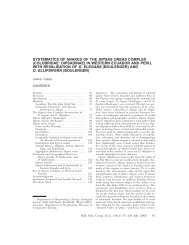cryptic species within the dendrophidion vinitor complex in middle ...
cryptic species within the dendrophidion vinitor complex in middle ...
cryptic species within the dendrophidion vinitor complex in middle ...
You also want an ePaper? Increase the reach of your titles
YUMPU automatically turns print PDFs into web optimized ePapers that Google loves.
SPECIES IN THE DENDROPHIDION VINITOR COMPLEX N Cadle 201<br />
Dendrophidion apharocybe previously<br />
has been confused with ano<strong>the</strong>r new<br />
<strong>species</strong>, D. crybelum, and with D. <strong>v<strong>in</strong>itor</strong><br />
as redef<strong>in</strong>ed here<strong>in</strong>. Dendrophidion apharocybe<br />
differs from D. crybelum (characters<br />
<strong>in</strong> paren<strong>the</strong>ses) <strong>in</strong> <strong>the</strong> follow<strong>in</strong>g hemipenial<br />
characters: hemipenis ra<strong>the</strong>r short and with<br />
a bulbous apex compris<strong>in</strong>g well over onethird<br />
<strong>the</strong> length of <strong>the</strong> organ (longer and<br />
cyl<strong>in</strong>drical, without a dist<strong>in</strong>ctly expanded<br />
apex that comprises one-fourth or less <strong>the</strong><br />
length of <strong>the</strong> hemipenis); apex strongly<br />
<strong>in</strong>cl<strong>in</strong>ed toward <strong>the</strong> sulcate side and nude<br />
(not <strong>in</strong>cl<strong>in</strong>ed and ornamented with many<br />
free-stand<strong>in</strong>g membranous ridges hav<strong>in</strong>g<br />
embedded sp<strong>in</strong>ules); hemipenis with relatively<br />
few moderately enlarged sp<strong>in</strong>es, total<br />
enlarged sp<strong>in</strong>es ,45 (many greatly enlarged<br />
sp<strong>in</strong>es, total enlarged sp<strong>in</strong>es .70). Dendrophidion<br />
apharocybe and D. crybelum are<br />
very similar <strong>in</strong> color patterns, but D.<br />
apharocybe has immaculate ventrals and<br />
subcaudals, whereas adult D. crybelum have<br />
small dark spots on <strong>the</strong> posterior ventrals<br />
and <strong>the</strong> subcaudals (juveniles sometimes<br />
have only dark suffusion on <strong>the</strong> subcaudals);<br />
see <strong>species</strong> account for D. crybelum for<br />
details. Dendrophidion apharocybe averages<br />
more pale body bands (Table 1) than D.<br />
crybelum (p , 0.001) and fewer than D.<br />
<strong>v<strong>in</strong>itor</strong> (p , 0.001), but <strong>the</strong> ranges overlap<br />
greatly <strong>in</strong> each case.<br />
Hemipenes of D. apharocybe and D.<br />
<strong>v<strong>in</strong>itor</strong> are similar <strong>in</strong> overall shape, but <strong>the</strong><br />
apex of <strong>the</strong> former is nude and strongly<br />
<strong>in</strong>cl<strong>in</strong>ed toward <strong>the</strong> sulcate side, and it lacks<br />
an apical boss. The hemipenis of D. <strong>v<strong>in</strong>itor</strong><br />
has a highly ornate apex, <strong>in</strong>clud<strong>in</strong>g an apical<br />
boss, and it is not strongly <strong>in</strong>cl<strong>in</strong>ed (see<br />
detailed hemipenial descriptions). Additionally,<br />
<strong>the</strong>se two <strong>species</strong> differ <strong>in</strong> aspects of<br />
color pattern (see <strong>species</strong> account for D.<br />
<strong>v<strong>in</strong>itor</strong>).<br />
Description (31 males, 34 females). Table<br />
1 summarizes size, body proportions,<br />
and meristic data for D. apharocybe;<br />
McCranie (2011) summarized data for 10<br />
Honduran specimens, most of which are<br />
also <strong>in</strong>cluded <strong>in</strong> this summary. Largest<br />
specimen (KU 35638) a female 1,045 mm<br />
total length, 672 mm SVL. Largest male<br />
(KU 80223) 1,040 mm total length, 653 mm<br />
SVL (ano<strong>the</strong>r male, LACM 148601, was also<br />
653 mm SVL but had an <strong>in</strong>complete tail).<br />
Tail 35–38% of total length (53–61% of<br />
SVL) <strong>in</strong> males; 33–36% of total length (49–<br />
57% of SVL) <strong>in</strong> females. Dorsal scales <strong>in</strong><br />
17–17–15 scale rows, <strong>the</strong> posterior reduction<br />
by fusion of rows 2+3 (40%) or 3+4<br />
(54%) or loss or row 3 (6%) at <strong>the</strong> level of<br />
ventrals 85–105 (see Sexual Dimorphism<br />
below). Ventrals 149–160 (averag<strong>in</strong>g 153.9)<br />
<strong>in</strong> males, 152–168 (averag<strong>in</strong>g 160.8) <strong>in</strong><br />
females; 1 or 2 preventrals anterior to<br />
ventrals (preventrals rarely absent). Anal<br />
plate s<strong>in</strong>gle. Subcaudals 115–127 (averag<strong>in</strong>g<br />
121.1) <strong>in</strong> males, 111–129 (averag<strong>in</strong>g 119.9)<br />
<strong>in</strong> females. Dorsocaudal reduction at subcaudals<br />
32–63 <strong>in</strong> males (mean 47.8), 26–52<br />
<strong>in</strong> females (mean 41.5). Preoculars 1,<br />
postoculars nearly always 2 (rarely 3),<br />
primary temporals usually 2 (rarely 1),<br />
secondary temporals usually 2 (rarely 1),<br />
supralabials usually 9 with 4–6 border<strong>in</strong>g<br />
<strong>the</strong> eye (range 8–10 with o<strong>the</strong>r comb<strong>in</strong>ations<br />
border<strong>in</strong>g <strong>the</strong> eye; Table 1), <strong>in</strong>fralabials<br />
usually 9 (range 7–10). Maxillary teeth<br />
33–44 (averag<strong>in</strong>g 39), typically with four<br />
posterior teeth abruptly enlarged; sometimes<br />
<strong>the</strong> enlargement appeared more<br />
gradual and with three or five somewhat<br />
enlarged (Fig. 8).<br />
Two apical pits present on dorsal scales.<br />
Nearly 60% of specimens have all dorsal<br />
rows except row 1 keeled on <strong>the</strong> neck (<strong>in</strong><br />
about half of those, keels on row 2 were<br />
scored as weak); ano<strong>the</strong>r 34% of specimens<br />
lacked keels on rows 1 and 2 on <strong>the</strong> neck (<strong>in</strong><br />
one-quarter of those keels were weak on<br />
row 3); <strong>the</strong> rema<strong>in</strong><strong>in</strong>g specimens lacked<br />
keels on rows 1–3 on <strong>the</strong> neck (<strong>the</strong>se<br />
proportions differ from D. crybelum; see<br />
<strong>species</strong> account). In all except five specimens,<br />
keels were present on all dorsal rows<br />
except row 1 at mid- and posterior body; <strong>in</strong><br />
<strong>the</strong> five exceptions (four from Panama, one<br />
from Costa Rica) keels were present additionally<br />
on scale row 1 posteriorly (sometimes<br />
weak). Fusions or divisions of temporal<br />
scales were common, with <strong>the</strong> follow<strong>in</strong>g<br />
Bullet<strong>in</strong> of <strong>the</strong> Museum of Comparative Zoology harv-160-04-01.3d 11/4/12 19:58:55 201







